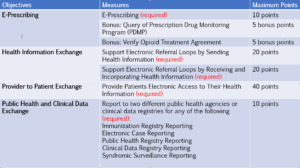The MIPS Promoting Interoperability (PI) performance category underwent an overhaul in 2019. This page will provide an overview of the structure and requirements of the PI performance category for performance year 2019.
Physicians and group practices that include physicians are required to report data from the PI category in order to avoid losing the 25 MIPS points assigned to this performance category. All practices must use 2015 Edition Certified Electronic Health Record Technology (CHERT) in 2019, or they will receive zero points in this category.
The minimum reporting period is 90 consecutive days.
As shown in the figure there are 4 objectives and 11 measures. Practices must complete the minimum requirements in all 4 objectives or they will receive a score of zero points for the entire PI category. (Please also see the MIPS Promoting Interoperability Checklist (2019).
The e-prescribing objective includes the mandatory e-prescribing measures and two optional bonus measures. Failure to write at least one prescription will result in a PI score of zero points. The e-Prescribing measure requires that physician write prescriptions electronically, including the query of a drug formulary during the prescribing process, using 2015 edition CEHRT. This is a performance measure worth up to 10 points (out of 100 total maximum points in this category). The score is based on the percentage of prescriptions written where compliant e-prescribing technology was used divided by the total number of prescriptions written.
The optional opioid measures are not widely available. They impart a 5-point bonus per measure.
One of the measures it titled: “Query of Prescription Drug Monitoring Program (PDMP).” It looks at the number of times a PDMP was queried when a Schedule 2 opioid medication was prescribed, divided by the total number of Schedule 2 opioid medications prescribed. If the PDMP is queried for just one patient that practice will receive the full 5 bonus points for this measure.
The other measure is titled “Verify Opioid Treatment Agreement.” It looks at the number of times an opioid treatment agreement was identifies and incorporated into the EHR divided by the total number of Schedule 2 opioid drugs prescribed during the performance period. It also only requires that the measure’s performance requirement be met for one patient for the practice to receive the full 5-point bonus.
The next objective, Health Information Exchange, has two measures. At least one patient must meet the requirements for each of these two measures for the practice to avoid receiving a score of zero for the entire PI performance category. Each measure is values at 20 points in this performance category.
The first measure under this objective, Support Electronic Referral Loops by Sending Health Information, looks at the number of referrals and transitions of care where the clinician exported and sent a summary of care document using a secure messaging platform. This denominator is made up of all patients sent in transition of care or as referrals by the clinician to another setting of care. The sending clinician has to have reasonable certainty that the receiving facility can receive and import the information into their EHR.
The second measure under this objective, Support Electronic Referral Loops by Receiving Health Information, looks at how often a summary of care document was received and imported in the receiving practices EHR for patients received in transitions of care, as referral and as patients “never before encountered by the clinician.”
The Provider to Patient Exchange Objective has one measure. It is the “Provide Patients Electronic Access to Their Health Information” and it looks at the percentage of patients in your practice that were able to download, transmit and view their health information (via and app or patient portal) during the performance period. This measure is worth up to 40 points.
The fourth objective is titled “Public Health and Clinical Data Exchange.” It is worth up to ten points. There are 5 measures under this objective:
- Immunization Registry Reporting
- Electronic Case Reporting
- Public Health Registry Reporting
- Clinical Data Registry Reporting
- Syndromic Surveillance Reporting
The measures are reported using attestation. There is no data requirement. If the practice attests to meeting the requirements for two of the above measures (or has two separate interfaces within the same measure type) they will receive the full 10 points for this objective. If an interface is active for only one interface (and no exclusion is claimed) the practice will receive 5 of the maximum 10 points from this objective.
Additional, more in-depth information on PI performance as well as extensive references are available at: MIPS Promoting Interoperability Checklist (2019)
CMS will allow for PI category hardship exceptions for certain specified reasons. The application process for 2019 is currently open. All hardship applications need to be received by December 31st. Detailed information on hardhip exceptions are available at: MIPS Promoting Interoperability Hardship Exceptions.
For further information please contact us at info@apollohit.com.
Disclaimer: the information provided on this website contains interpretations of guidance provided by CMS. Please review the official guidance provided by CMS.
©Apollo HIT, LLC. All rights reserved.


